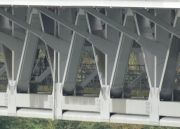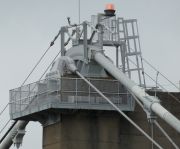Tamar Suspension Bridge










The bridge crosses the River Tamar between Devon and Cornwall, alongside Brunel's Royal Albert Bridge.
The Tamar suspension bridge was opened in April 1962, the first of the post-war suspension bridges in Britain. It was designed by Mott, Hay and Anderson, and constructed by the Cleveland Bridge and Engineering Co.
Main span 335m, two side spans of 114m.
The towers are constructed from reinforced concrete. The 350mm diameter main suspension cables have 31 locked coil wire ropes. The steel stiffening girder is 5.5 m deep.
See here for a film recording the construction of the bridge.
The bridge was unable to meet a new EU Directive that bridges should be capable of carrying lorries up to 40 tonnes. The cost of a new bridge was prohibitive, and in the late 1990s an innovative solution was proposed to strengthen the bridge. A major constraint was the requirement to keep the bridge open to traffic throughout the work.
Contracts were placed with Hyder Special Structures and Kvaerner Cleveland Bridge to strengthen the bridge and to widen it by adding a cantilevered lane on each side of the existing deck. These additional lanes would be used to temporarily carry the traffic and allow work to be carried out on the original roadway, and would subsequently be used as pedestrian and cycle ways.
Major strengthening and replacement work was undertaken on the suspended superstructure and the approach spans. This included the addition of eighteen new locked-coil stay cables, nominally 10 cm diameter, to supplement the original suspension system, helping to carry the additional load of the new cantilever lanes and associated temporary works. Work also included replacement of the original deck steelwork in the approach spans, replacement of the concrete deck by a stronger and lighter three-lane orthotropic steel deck in the suspended spans, the erection of the new deck cantilever steelwork, strengthening the truss by installing supplementary inverted U-shaped members below the bottom chord and by welding additional plates at key locations. Two of the stay cables run in these inverted U-girders. The work was completed in 2001. [1] [2] [3]
See Also
Sources of Information
- ↑ DLT Engineering - Tamar suspension bridge strengthening & widening, UK
- ↑ 'Modal Testing of Tamar Suspension Bridge' by J.M.W. Brownjohn, A. Pavic, P. Carden, C. Middleton, Vibration Engineering Section, University of Sheffield
- ↑ Structural health monitoring of the Tamar suspension bridge by K.Y. Koo, J.M.W. Brownjohn, D.I. List, R. Cole

